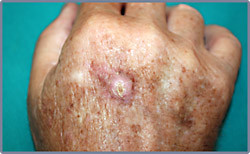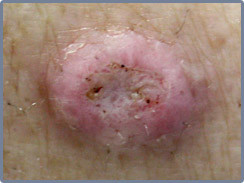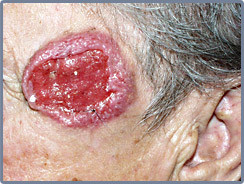Squamous Cell Carcinoma
Squamous cell carcinoma (SCC) is a common skin cancer in humans. About 700,000 new cases of this skin cancer are diagnosed in the United States each year.
This skin cancer tends to develop on skin that has been exposed to the sun for years. It is most frequently seen on sun-exposed areas, such as the head, neck, and back of the hands. Women frequently get SCC on their lower legs.
It is possible to get SCC on any part of the body, including the inside of the mouth, lips, and genitals.
People who use tanning beds have a much higher risk of getting squamous cell carcinoma. They also tend to get them earlier in life.
Squamous cell carcinoma can spread to other parts of the body. This is uncommon. With early diagnosis and treatment, SCC is highly curable.
-
The only way to diagnose any type of skin cancer, including squamous cell carcinoma, is a with a skin biopsy. Your dermatologist can perform this procedure during an office visit.
A skin biopsy should not cause anxiety. To perform a skin biopsy, your dermatologist will remove the entire growth or part of it. Your dermatologist may send this to a laboratory or look at it under a microscope. The finding will be communicated in a biopsy report.
If the biopsy report states that you have SCC, your dermatologist will consider many factors to determine which treatment will be best.
The type of treatment a patient receives depends on how deep the cancer has grown and whether it has spread. Squamous cell carcinoma is often treated with:
Excision: This is a surgical procedure that your dermatologist often can perform during an office visit. It involves numbing the area to be treated and cutting out any remaining tumor plus some normal-looking skin around the tumor.
Like the skin biopsy, this removed skin is examined under the microscope. This may be done at a laboratory or by your dermatologist. The doctor who looks at the removed skin needs to see whether the normal-looking skin is free of cancer cells. If not, more skin will need to be removed. This is a common way to treat SCC.
Mohs surgery: Named for the doctor who developed this surgery, Mohs (pronounced “moes”) is a specialized surgery used to remove some skin cancers. It offers the highest cure rate for difficult-to-treat squamous cell cancers. Your dermatologist will tell you if Mohs surgery is right for you.
If Mohs surgery is recommended, this is what you can expect. The surgeon will cut out the tumor plus a very small amount of normal-looking skin surrounding the tumor. While the patient waits, the Mohs surgeon uses a microscope to look at what was removed. The surgeon is looking for cancer cells.
If necessary, the Mohs surgeon will continue to remove a very small amount of skin and look at it under the microscope. This continues until the surgeon no longer sees cancer cells.
Radiation: This treatment is usually reserved for SCCs that cannot be cut out, or when cutting may not be the best choice. A patient may need 15-30 radiation treatments.
When the SCC is caught early, it may be treated by:
Curettage and Electrodessication: This treatment consists of two steps. First, your dermatologist scrapes away the tumor. Then electricity is used to destroy any remaining cancer cells. These two steps are repeated.
Laser Treatment: Lasers can be used to remove an SCC that sits on the surface of the skin. This treatment is only recommended for early SCCs.
Chemotherapy Cream: Cream that contains a chemotherapy drug, 5-fluorouracil (5-FU), can be used to treat SCC in the earliest stage.
Outcome
With treatment, most SCCs are cured. Early treatment is recommended. When allowed to grow, this skin cancer can grow deep, destroying tissue and even bone. In some cases, SCC spreads to the lymph nodes and other parts of the body. This can cause serious health problems.
-
This skin cancer is most common in fair-skinned people who have spent years in the sun. But people of all skin colors get squamous cell carcinoma (SCC). Your risk of developing SCC increases if you have any of the following risk factors:
Your Physical Traits
— Pale or light-colored skin.
— Blue, green, or gray eyes.
— Blond or red hair.
— An inability to tan.What You’ve Done
— Spent a lot of time outdoors, for work or leisure, without using sunscreen or covering up with clothing.
— Used tanning beds or sunlamps.
— Been exposed to cancer-causing chemicals (e.g., arsenic in drinking water, tar, worked with some insecticides or herbicides).
— Smoked tobacco.
— Spent lots of time near heat, such as a fire.Your Medical History
— Diagnosed with actinic keratoses (AKs)
— Badly burned your skin.
— Ulcer or sore on your skin that has been there for many months or years.
— Taking medicine that suppresses your immune system.
— Infected with human papillomavirus (HPV)
— Overexposure or long-term exposure to x-rays, such as patients who received x-ray treatments for acne in the 1940s.
— Received many PUVA treatments.
— Have one of these medical conditions: xeroderma pigmentosum, epidermolysis bullous, or albinism.Causes
Most SCC is caused by ultraviolet (UV) rays from the sun or tanning beds. Other causes include:
— Long-term exposure to cancer-causing chemicals, such as when a person smokes tobacco, is exposed to tar, drinks from a water supply that contains arsenic, or uses some insecticides or herbicides.
– A serious burn
— Ulcer or sore on the skin that has been there for many months or years.
— Some types of the human papillomavirus (HPV). -
Most people diagnosed with squamous cell carcinoma (SCC) have a very good prognosis. When caught early and removed, this skin cancer has an excellent cure rate.
Risk
Anyone who has had SCC has a higher risk for getting another skin cancer.
To help patients manage this higher risk, dermatologists recommend the following:
Keep all follow-up appointments with your dermatologist. When found early, skin cancer usually can be cured. Even melanoma, the deadliest skin cancer, has a cure rate of nearly 100% when found early and treated.
Perform skin self-exams. Patients who are diagnosed with skin cancer are taught how to examine their own skin for signs of skin cancer. Be sure to examine your own skin as often as recommended by your dermatologist.
If you see anything on your skin that is growing, bleeding, or in any way changing, immediately call your dermatologist’s office. Change can be a sign of skin cancer. Found early and treated, skin cancer can be cured.
Protect your skin from the sun and indoor tanning. This is essential to prevent further damage, which can increase the risk of getting another skin cancer.
Here are tips that dermatologists give their patients to help them protect the skin:
— Wear sunscreen and lip balm that offers sun protection. Apply these daily, even in the winter, and be sure to use sunscreen and lip balm that offer:
— SPF 30 or higher
— Broad-spectrum (UVA/UVB) protection
Water resistance
— Apply the sunscreen and lip balm to dry skin 15 minutes before going outdoors.
— Apply the sunscreen to every part of your body that will not be covered by clothing.
— Whenever possible, wear a wide-brimmed hat, long sleeves, and pants.
— Wear sunglasses to protect the skin around your eyes.
— Avoid outdoor activities when the sun is strongest – between 10 a.m. and 2 p.m.
— Avoid tanning and never use a tanning bed or sun lamp.Use condoms. Your dermatologist may recommend using condoms. This can prevent an HPV infection, which reduces the risk for getting SCC on the genitals.
Limit the amount of alcohol you drink and do not smoke. Smoking and drinking can increase your risk of getting SCC in your mouth.





